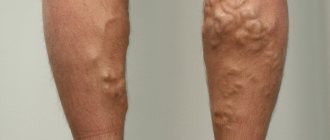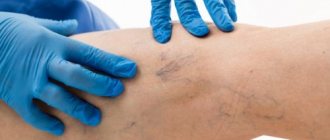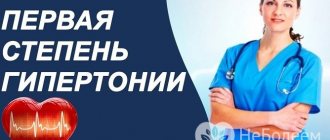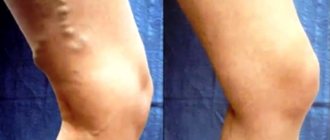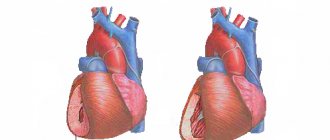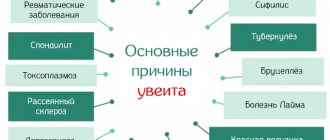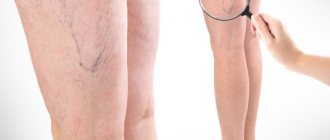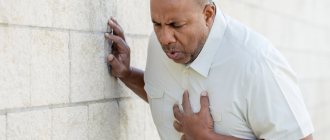Symptoms of the first stage
Varicose veins of the 1st degree are characterized by the absence of external manifestations. The onset of the disease can be suspected by the following signs:
- Increased leg fatigue;
- Nagging pain at the end of the working day;
- Convulsions;
- Swelling of the feet and legs in the evening.
Some patients experience restless legs syndrome - lying in bed, a person cannot find a comfortable position, and there is a feeling of discomfort in the legs. This leads to sleep disturbance. Symptoms worsen in hot weather.
How to diagnose pathology
When the first signs of discomfort in your legs appear, you should contact a medical facility. The diagnosis and treatment of venous insufficiency is carried out by a phlebologist, but an initial consultation can be obtained from a therapist.
- A visual inspection of the condition of the integument on the legs, the presence of orthopedic changes and other signs is carried out;
- Palpation of problem areas not only of the legs, but also of the groin area and abdominal area;
- The patient's complaints are listened to;
- A detailed medical history is compiled in the form of a conversation-survey. The questions are aimed at identifying the cause that became the starting point in the formation of varicose veins;
- It is mandatory to write out a referral for general blood and urine tests to determine the general well-being of the patient;
- Functional testing to determine the degree of venous expansion (Schwartz, Perthes methods, plantar testing);
- For varicose veins, a hardware examination of the patency of the veins and the condition of the venous valves is carried out - duplex ultrasonography (DUS), plethysmography, phlebography, rheovasography.
After all measures have been taken to diagnose venous insufficiency and determine the degree of varicose veins, prevention, conservative therapy, treatment with traditional methods and, in extreme cases, surgical intervention and elimination of pathology with a laser are prescribed.
Symptoms of the second stage
With grade 2 varicose veins, the symptoms are much more pronounced. They appear already at the height of the working day, and reach their maximum in the evening. The pain is so severe that painkillers are required.
This stage is characterized by the appearance of clinical signs:
- Severe swelling of the extremities;
- Specific spider veins are dilated small veins located just under the skin.
In these areas there is increased pain and itching. By the end of the second stage of varicose veins of the lower extremities, the veins become visible under the skin in the form of blue spots and stripes.
At this stage, the disease is still curable. A person can get rid of the disease if he seeks medical help in a timely manner.
Different stages of development of venous insufficiency
Despite the fact that veins in humans are localized not only in the legs, but throughout the body, varicose veins of the lower extremities are more common. Both women and men suffer from the disease, but a larger percentage affects the fair half of the population.
There are several stages of varicose veins, which are classified according to severity. The division is conditional so that the attending physician makes a diagnosis and knows what treatment regimen to prescribe to the patient for specific complaints.
Among medical experts, there are a number of classifications of the stages of varicose veins. The international community distinguishes seven stages of varicose veins, drawing the line within the framework of narrow symptoms. But in practice, varicose veins are diagnosed according to 3 stages of the disease gradation:
- The first degree (compensation stage) - the deterioration of blood flow from the legs to the heart is predetermined by lifestyle or genetically, but the patient has time to return the venous valves to normal functionality. Symptoms of varicose veins at the initial stage are weak and are not taken seriously;
- Second degree (subcompensation) - there are visual signs of venous insufficiency, which are difficult to confuse with other changes. Discomfort in the legs disappears after a long rest or accompanies the person constantly. At this stage, patients most often seek help from a doctor. Vascular and venous changes are significant, but tension and pain can be relieved from the lower extremities;
- The third degree (decompensation) is the last stage of varicose veins, when the thin walls of the circulatory system begin to burst from excess blood. The skin tissues do not receive nutrition and they die. Skin ulcers occur that are difficult to treat. In some cases, with grade 3 varicose veins, bacteria are attached to the ulcerative lesions. Stabilizing the patient's condition requires time, effort and complex therapy.
The listed stages of varicose veins are a conditional division. Within each group of venous insufficiency, there is a mild, moderate and severe degree of the disease, which is determined by the symptoms described by patients at the appointment. Based on the fact that the pathology of the veins is individual in each case, the transition from one stage to another is insignificant, especially in cases of degrees 1 and 2.
Symptoms of the third stage
Grade 3 varicose veins are characterized by pronounced deformation of the vascular wall - it thickens, and the vessels become tortuous. Veins protrude noticeably under the skin, resembling bunches of grapes.
A person is worried about severe pain in the legs, cramps, and fatigue. Swelling appears both in the evening and in the morning. This stage of varicose veins is characterized by a change in the condition of the skin. It becomes excessively dry and flaky. These manifestations are especially pronounced in the area of deformed veins.
At the third stage, complications of the disease develop - thrombophlebitis and thromboembolism. Their appearance is associated with severe stagnation of blood in the vessels, resulting in the formation of blood clots. With thrombophlebitis, inflammation of the venous wall occurs, which is manifested by increased temperature and severe pain in the legs.
Thromboembolism is a dangerous complication of varicose veins associated with the detachment of a blood clot from the venous wall and its entry into large vessels. Most often, blood clots from the leg veins enter the pulmonary artery. This causes pulmonary edema and death occurs within minutes.
Reasons for appearance
According to statistics, more than 60% of women and about 50% of patients of the stronger sex suffer from varicose veins of the extremities in varying degrees of severity.
There are many reasons that are the trigger for the development of the disease. Key factors include:
- Hereditary predisposition. A genetically determined connective tissue defect is one of the most common causes of the disease. Manifested by weakness of the vascular walls.
- Gender (ladies are more susceptible to varicose veins). Experts associate the appearance of the disease with changes occurring in a woman’s body at different periods. Pregnancy, childbirth, menopause are conditions accompanied by weight gain, changes in hormonal levels, and deformation of blood vessels.
- Excess body weight, which impedes the flow of blood in the veins, is a reason that increases the risk of developing the disease in women of fertile age by 5 times.
- Nutritional features. Lack of vitamins and plant fibers disrupt the natural regeneration of vein walls.
- Limiting physical activity. Stagnation of blood in the lower extremities is often caused by lack of movement and prolonged sitting. Professions that involve working “on your feet” (surgeon, cook) are also a high-risk factor.
- Inflammatory diseases arising in the pelvic organs, endocrine disorders, heart and central nervous system diseases, flat feet.
- Injuries to bones and soft tissues of the legs.
In addition to the above, significant factors are also: a person’s age (a decrease in the elasticity of blood vessels is genetically determined by the aging process), the presence of bad habits.
Tight clothing, uncomfortable shoes with very high heels, regular lifting of weights, taking hormonal medications - all of the above reasons can also cause the described illness.
Symptoms of the fourth stage
This is already advanced varicose veins of the legs. The veins are even more deformed, resembling tourniquets or ropes under the skin. Touching them is painful, they are almost always in the stage of inflammation. Lymphostasis develops - stagnation of lymph in the vessels. The legs swell greatly, and the swelling does not subside even with rest.
Characterized by severe pain in the limbs, a person cannot walk even a few meters. The pain is constant, even when lying down. Convulsions occur frequently. The skin on the legs peels off, trophic ulcers form, which quickly fester - a typical sign of the disease. A change occurs in the nails - they break and crumble, and fungus easily develops.
The third and fourth stages of the disease are subject to urgent comprehensive treatment.
Below are photos of the stages of varicose veins.
It is necessary to treat varicose veins as early as possible, when the first subjective sensations appear. This is the only way to achieve complete restoration of the vascular wall. In later stages, treatment is aimed at slowing the progression of the disease, correcting symptoms and preventing complications.
Treatment of varicose veins is carried out using non-drug methods, taking medications and performing surgery. At each stage of varicose veins, its own therapeutic tactics are used.
General principles
General measures are taken for all stages of varicose veins. These are non-drug methods:
- Daily regime;
- Nutrition;
- Use of compression stockings.
Patients with venous insufficiency of the lower extremities should review their daily routine and adjust it.
- A full sleep is necessary - at least 8 hours a day, in a lying position.
- Moderate physical activity and sufficient physical activity during the day are indicated.
- If your profession involves standing on your feet for a long time, you need to change your body position every hour - sit down, if possible lie down for 5-7 minutes. While standing, it is advisable to shift from foot to foot, take steps forward and to the sides, and raise your knees.
- In the evenings, you need to lie on your back, raise your legs up, make swings and movements that imitate riding a bicycle.
- Daily walking, cycling, and swimming are beneficial. The volume and types of physical activity are determined by the attending physician.
- It is necessary to give up bad habits - smoking and drinking alcohol.
- Women are not recommended to wear high-heeled shoes, especially if they have to stand or walk a lot during the day.
Varicose veins of the lower extremities require adherence to the principles of a healthy diet. Preservatives, fatty and fried foods should be excluded from the diet. Fruits and vegetables, meat and seafood are useful for strengthening the vascular wall.
At any stage of varicose veins on the legs, it is recommended to wear special compression hosiery. The therapeutic effect of this knitwear is to apply uniform pressure on the limb and stimulate blood flow through the veins, preventing stagnation.
The simplest type of compression hosiery is elastic bandages. They must be put on every morning and taken off in the evenings. There are certain rules for applying bandages:
- The process is carried out in a lying position, before getting out of bed;
- Apply a bandage from bottom to top;
- First, the bandage is passed around the foot several times, then it is raised to the thigh and secured with a special fastener;
- Apply an elastic bandage in a circle - each round of the bandage should overlap the previous one by about a third;
- The bandage is applied with uniform stretching over the entire limb.
Since elastic bandages are quite inconvenient to use, during walking they can slip and cease to perform their function, it is recommended to purchase ready-made stockings, knee socks and tights. They are divided into several degrees of compression - each stage of the disease has its own degree assigned. The attending physician prescribes this or that underwear. There are several sizes of compression garments, so you can choose one for any leg.
Read also: Varicose veins in the abdominal cavity
Drug treatment
At the first stage of varicose veins, treatment is allowed only with conservative methods. Sometimes it is enough in the second stage. It is carried out by several groups of medicines.
- Venotonics - Detralex, Phlebodia, Troxerutin, Antistax. These drugs increase the tone of the vascular wall and reduce their permeability. Thanks to this, pain is reduced and bruises on the skin are eliminated. The drugs are taken in tablets, the course of treatment is 2-4 weeks.
- Preparations with heparin - Lyoton, Venolife, Trombless, heparin ointment. Helps reduce swelling of the skin, eliminate burning and itching. Apply them in the evenings, applying to problem areas and rubbing lightly.
- Vitamins. The drug Ascorutin contains ascorbic acid and rutin. These substances help strengthen the vascular wall and slow down the process of its deformation.
Drug treatment alone is not enough to get rid of the disease. Taking medications should be combined with diet and sufficient physical activity, as well as wearing compression garments.
Surgery
It is carried out in the later stages of the disease. In the third degree, sclerotherapy is added to the above methods. The essence of the procedure is to introduce a substance into the deformed vein that closes its lumen. In this way, only affected vessels can be excluded from blood circulation, leaving healthy ones to function.
Using sclerotherapy, spider veins and medium-sized veins are removed. The procedure is performed on an outpatient basis and takes about 10 minutes. After the procedure, it is recommended to wear a compression stocking.
Sclerotherapy is not enough to treat grade 4 varicose veins. Deformed veins are removed in several ways.
- Application of laser. The laser beam acts on the affected vein for several minutes. As a result, coagulation of the endothelium and closure of the vessel occurs. The procedure takes about 40 minutes and leaves no scars on the skin.
- Radiofrequency ablation. Performed under local anesthesia. A special catheter is inserted into the deformed vein and radio waves are applied to the vascular wall. As a result, the walls stick together and the vein is turned off from the bloodstream.
- The most radical is the traditional surgical intervention - phlebectomy. The technique is indicated for the development of phlebothrombosis and a high risk of thromboembolic complications. The operation is performed under general anesthesia. Using the ultrasound method, the boundaries of deformed veins are determined and marked on the skin. Then an incision is made in the skin and subcutaneous tissue, the vein is clamped and removed.
There are contraindications for surgical interventions - pathology of blood clotting, severe diseases of internal organs.
ethnoscience
Home recipes are actively used in the treatment of varicose veins. They can be used only in consultation with the attending physician, without replacing the main treatment with folk remedies.
- 200 g nutmeg, liter of vodka. Leave for 10 days, take 20 drops three times a day.
- 250 g garlic, 350 g honey. Mix and leave for 2 weeks. Take a teaspoon three times a day.
- 100 g aloe leaves, 500 ml vodka. Leave for 10 days and rub your feet before going to bed.
Varicose veins on the legs are a dangerous disease. It must be treated in a timely manner using a combination of various methods. At each stage of varicose veins on the legs, certain therapeutic measures are indicated.
Prevention
To prevent the development of varicose veins, you need to know a few simple rules:
- Wear comfortable shoes. Stiletto heels should be worn for the occasion. The maximum permissible heel height is 5 cm.
- Do not overuse strong tea and coffee.
- Eliminate heavy foods from your diet that contribute to the formation of cholesterol plaques.
- If possible, break away from bad habits.
- Monitor your weight. An increase in body weight leads to deterioration of the veins.
- Dear ladies need to get rid of the habit of sitting cross-legged.
- If you carry heavy objects, distribute the load on both sides evenly, resting periodically.
- Do gymnastics from the set of exercises suggested above.
- For preventive purposes, take baths and contrast showers.
It happens that the appearance of “stars” and “cobwebs” is not accompanied by pain. The disease is difficult to detect at an early stage. Therefore, periodic visual examination of the lower extremities is necessary.
Phlebologist Andrey Chupeev will tell you in a short video how to check the condition of your legs so as not to miss the first symptoms of varicose veins:
According to statistics, a third of the female population suffers from varicose veins. Almost all representatives of the fair sex are at risk. The possible occurrence of the disease can be avoided by following the rules of prevention. The presence of alarming symptoms is the first signal to contact a specialist.
Website about varicose veins: symptoms and treatment of varicose veins
Depending on the symptoms that the patient feels, as well as the objective clinical signs of varicose veins, determined by the doctor during examination, varicose veins are divided into several stages. According to the international classification, there are 7 of them, starting from C0 (C - from the English “class”, not the Russian “stage”) and ending with C6. Let's talk about how this disease develops and what main differences are characteristic of each stage.
Initial stage of varicose veins (C0)
The initial stage of varicose veins is characterized by the absence of visible changes in the veins. Although the patient already has complaints. He feels:
- heaviness in the legs; - rapid fatigue; - night cramps; - sometimes - mild swelling that goes away after rest.
In the morning, all these symptoms disappear on their own, appearing to a greater extent in the afternoon. What should a person do if they feel the early symptoms of varicose veins? There are only two options:
1. Lead the same lifestyle, wait for the further development of the disease - that is, its transition to the next stage.
2. Take preventive measures to prevent the progression of varicose veins.
Let's give some recommendations for people who choose the second option:
- don't wear high-heeled shoes (or at least don't do it too often);
never stand or sit in one position for more than 1 hour - be sure to warm up by doing squats or just walking along the corridor;
in the evenings, practice self-massage, contrast shower;
if you have problems with excess weight, take measures to normalize it;
do physical activity, swim;
- Before going to bed, it is advisable to put your feet on a pillow for 10-20 minutes (prevention of swelling).
- tree-like;
- spiral;
- arachnid;
- pinpoint (up to 1 mm in diameter).
First stage of varicose veins (C1)
In the first stage of varicose veins, veins become visible. The key feature of stage C1 is the presence of two (or one of two) signs:
1. Varicose saphenous veins. There are no nodes yet, but the venous network is already clearly visible.
2. Telangiectasia - spider veins that are formed due to the fusion of small dilated intradermal veins. May have different shapes:
Spider veins create a cosmetic defect that many women are unhappy with. They can be removed by using some therapeutic techniques. The skin will become more beautiful, but this will not affect the prognosis of varicose veins.
The first stage of the disease usually lasts a very long time - several years or several decades. Due to the internal mechanisms of hemodynamic compensation, the formation of the pathological process occurs extremely slowly, which gives a person the opportunity to prevent the transition of varicose veins to the next stages by adjusting their lifestyle in time.
Second stage of varicose veins (C2)
In the second stage of varicose veins, varicose nodes appear. There are already pronounced hemodynamic disturbances. The venous valves, which are overloaded with blood volume, begin to suffer.
The second stage of varicose veins has two options:
C2A. It occurs without symptoms. That is, the veins are dilated, but this does not bother the patient in any way (except, perhaps, for an aesthetic defect).
C2S. Symptoms occur: heaviness in the legs, fatigue, low tolerance to physical activity, pain in the calf muscles, night cramps.
Read also: Varicocele infertility rate
Third stage of varicose veins (C3)
Edema is the main distinguishing feature of the third stage of varicose veins of the lower extremities. Swelling occurs even at the initial stage of the disease, but it is minor and goes away on its own after a short rest. There are never any in the morning. But with stage 3 varicose veins, the swelling is persistent - it is present not only in the evening, but also in the morning.
The appearance of edema indicates the formation of venous insufficiency. The valves can no longer cope with the pressure that a large volume of blood puts on them. The vascular venous bed is overloaded. It is difficult for veins to move blood upward, so plasma (the liquid part) leaks into the surrounding tissues through the walls of blood vessels, the permeability of which increases with varicose veins.
Fourth stage of varicose veins (C4)
The fourth stage of varicose veins is characterized by skin changes that occur as a result of impaired blood circulation. It is presented in two versions:
C4a. Skin hyperpigmentation. It acquires a brown tint and in some places becomes black. Inflammation develops. Varicose eczema forms.
C4b. Lipodermatosclerosis. These are dystrophic changes in subcutaneous fat that develop as a result of impaired blood supply to tissues. Multiple scars form in it. Lipodermatosclerosis is manifested not only by thickening of the skin, determined by palpation, but also by an increase in subjective symptoms. This pathological process significantly increases the intensity of the pain syndrome.
Fifth stage of varicose veins (C5)
Trophic ulcers are a symptom characteristic of stage C5. They can have different sizes, sometimes appear, sometimes disappear. When trophic ulcers heal, the disease returns again in the fourth stage.
The immediate causes of their formation are ischemia (insufficient blood supply) of tissues, their degeneration, the addition of bacterial flora with the development of inflammation. The healing time for ulcers increases, initially amounting to several weeks, then several months. In the end, they stop healing altogether, because the degenerative changes occurring in the skin and subcutaneous fat are irreversible. This is the main reason why it is recommended to treat varicose veins in the early stages.
Last stage of varicose veins (C6)
In the absence of treatment, the last, sixth stage of varicose veins develops. Only 0.5-1% of patients achieve it. The last stage of varicose veins is characterized by the appearance of active, never-healing ulcers.
Conclusion
According to the international classification, varicose veins of the legs are divided into stages (classes), depending on the clinical manifestations of the disease. Their brief description:
- C0 – no symptoms;
- C1 – the venous network is visible;
- C2 – venous nodes appear;
- C3 – swelling occurs;
- C4 – skin changes appear;
- C5 – healing trophic ulcers;
- C6 – non-healing trophic ulcers.
The earlier treatment is started, the better the prognosis. You should not delay visiting a doctor, because starting from stages 3-4, degenerative processes gradually develop in the skin and subcutaneous fat. They are irreversible.
Stages of varicose veins
Being a fairly common disease of the veins and arteries, varicose veins are accompanied by characteristic manifestations that make it possible to promptly diagnose the disease and prevent its worsening. There are certain stages of varicose veins, which are accompanied by certain symptoms and can become indicators of both the neglect of the pathological process and an opportunity to identify current changes.
However, phlebologists today do not have a consensus regarding the identification of stages of the disease, since the identification of manifestations and their characteristic course is not a constant value: each case has its own characteristics of the manifestation and course of this disease, and against the background of existing parallel current lesions of the body, there is a high probability of blurring manifestations, which may interfere with correct diagnosis.
How to determine the degree of varicose veins
It is logical to classify the stages of the disease according to its clinical picture. A diagram of the development of varicose veins is built, which consists of gradually appearing symptoms:
- individual venous stars;
- distinct mesh pattern;
- dilated veins;
- swelling of the legs;
- skin pigmentation;
- varicose eczema;
- venous insufficiency;
- healing ulcerations;
- trophic ulcers.
But symptoms alone, even characteristic ones, are not enough to determine the stage of varicose veins. The fact is that the clinical signs of this pathology are diverse and variable. In almost every case, the disease has its own individual manifestations and characteristics.
A distinct mesh pattern helps to see the development pattern of varicose veins much faster.
Doctors often encounter significant differences in the main diagnostic criteria, which are important for determining the stage of varicose veins. This:
- initial signs of pathological processes;
- rate of progression of varicose veins;
- volume of affected vessels;
- localization of dilated veins;
- symptoms of complications of varicose veins.
You can also classify pathology according to the form of vein deformations. Then the stages of the disease look like this:
- limited subcutaneous varicose veins;
- localized - with penetration into the superficial veins;
- common - with the return of blood into the superficial network of blood vessels;
- common - with the return of blood into the deep veins.
You can also classify pathology according to the form of vein deformations. The patient may develop limited subcutaneous varicose veins.
Systematization of the stages of the disease based on the following complications:
- significant swelling;
- bleeding wounds;
- development of thrombophlebitis;
- the appearance of trophic ulcers.
The more severe the degree of varicose veins, the more characteristic symptoms and complications there are, and all these options for systematizing the disease are somewhat one-sided. For a long time, Russian phlebologists were guided by a classification according to which varicose veins of the limbs go through 3 stages of development.
Basic parameters for determining the stage of varicose veins
The stages of varicose veins are usually formed depending on the totality of certain manifestations that characterize the degree of neglect of the current pathological process, as well as their impact on the patient’s body as a whole. Classification of the manifestations of this disease is the simplest method of making a preliminary diagnosis and determining a treatment regimen.
To determine the stage of this disease, it is necessary to answer a number of specific questions that will make it possible to understand the existing symptoms and, with their help, determine the degree of worsening of the process, which largely determines the possibilities for treatment.
Such questions should include:
- the presence of characteristic manifestations of varicose veins and the degree of their manifestation;
- location and strength of symptoms;
- the presence of external manifestations of changes in the condition of veins and large arteries;
- identification of concomitant manifestations that worsen the patient’s condition.
However, even without a detailed diagnosis by a phlebologist, during an external examination of the patient, a preliminary diagnosis can be made, which will allow one to draw up a treatment plan and, depending on the individual specific characteristics of the patient’s body, the presence of current concomitant diseases and susceptibility to the treatment, make certain adjustments to the treatment. When diagnosing a patient’s condition, it is important to determine what types of varicose veins occur, their location and the degree of neglect of the pathological process.
Most often, varicose veins affect the lower extremities, since it is this area of the human body that receives the most significant stress. At the same time, not everyone is aware of this load on the legs, and does not take care of them even if there are a number of manifestations that signal the need for a more attentive attitude to the limbs and veins. Therefore, to understand how the stages of varicose veins differ, it is necessary to obtain at least a general understanding of the manifestations of this pathology, which is distinguished by its seriousness and great dangers for the health of the legs and the human body as a whole.
Diagnostics
Before starting therapy for pathological dilation of the vessels of the venous bed in the lower extremities, it is necessary to undergo a full examination. For the most part, making a final diagnosis is not difficult for the specialist.
Diagnostic process.
However, to identify the correct stage of varicose veins, the patient must fulfill the following conditions:
- Visit a doctor and undergo a visual examination. The doctor will study the manifestations of the disease - all clinical signs are included in detail in the medical history. The doctor must review the patient's medical history.
- Perform duplex angioscanning.
- Undergo a Doppler ultrasound examination of the blood vessels of the lower extremities. The price of such an examination can vary significantly depending on the chosen clinic.
As additional measures that allow a specialist to establish the true degree of development of the pathology, the following hardware research methods are used:
- X-ray;
- rheovasography of the lower extremities;
- radionuclide.
Important! The optimal treatment method is determined after all necessary diagnostic measures have been carried out. The instructions given by the specialist must be followed. Only following all recommendations will ensure the patient’s complete recovery.
How to fight the disease?
After the patient has undergone the necessary diagnostic measures, the treating specialist has the opportunity to select the optimal treatment tactics, which are most likely to bring the required level of positive results.
Specifics of the classification of varicose veins
The stages of varicose veins may vary in shape and location of the current pathological process in the veins. This approach is most convenient for understanding the degree of neglect of the disease, and also makes it possible to determine the cause of its occurrence, which will allow the current manifestations of this condition and characteristic symptoms to be eliminated more quickly.
Types of varicose veins differ in several specific parameters. The use of a certain classification makes it possible to determine whether an existing disease belongs to a group, which facilitates further diagnosis and selection of a treatment system. The modern classification according to the location of the main nodes of varicose veins is as follows:
- Varicose veins located in the superficial layer of the skin and deep veins, while external manifestations are characterized by segmentation - changes in the condition of the veins are noted only in a certain area of the veins.
- Varicose veins of superficial and perforating veins, which are also noted in certain segments of the skin.
- Changes in the condition of the veins, in which varicose veins and pathological changes in the superficial veins are diagnosed in an unexpressed form, reflux.
- Varicose veins observed in deep veins, the development of reflux.
Read also: Varicocele surgery Moscow reviews
The presence of reflux indicates the presence of a certain pathology, since with reflux the blood flows in the opposite direction. This phenomenon usually aggravates the pathological process of changes in the veins, stimulating the worsening of varicose veins with subsequent coverage of an increasingly larger area of veins and arteries. All types of varicose veins may have signs of reflux, which is already a definite pathology and requires medical intervention.
Understanding the severity of the disease makes it possible to begin treatment in a timely manner, since even the initial stage of the process, which has a relatively small number of external manifestations, is dangerous for the health of the legs. Varicose veins of the 1st degree can be practically asymptomatic, but this does not mean that there is no need to treat the disease.
An external examination of the affected veins with modified veins will allow the specialist to roughly determine the likely cause of this disease. However, to clarify the diagnosis, one should undergo a full range of diagnostic procedures that will allow one to establish the extent of the autological process, as well as adjust the intended therapeutic effect to obtain the most pronounced and long-lasting positive results. The classification will help make a diagnosis in accordance with the external manifestations of the disease, as well as determine the system of therapeutic effects.
Consequences of lack of proper treatment
Varicose veins are far from a harmless pathology and not a cosmetic defect with which you can safely live until old age. This is a serious disease that is life-threatening if left untreated. Complications of varicose veins:
- inflammation and thrombosis of the superficial veins (thrombophlebitis), which is fraught with gangrene of the lower limb;
- deep vein thrombosis, which threatens pulmonary embolism and death if a blood clot breaks off;
- trophic ulcers are deep tissue lesions that do not heal for a long time, causing severe suffering to the patient.
Trophic disorders cause thinning of the skin and venous wall, which can lead to bleeding even with minor injuries. Treatment of varicose veins is a painstaking and lengthy task. But strict adherence to the doctor’s instructions gives good results and maintains health.
Classification depending on the degree of aggravation
Today, the generally accepted classification method should be considered a variant that divides the course of the disease into certain stages. Each of them has characteristic manifestations; with the onset of the next stage, a greater degree and strength of symptoms and a greater prevalence of the affected area are noted.
The classification of the disease, which is carried out depending on the degree of neglect, is as follows:
- early stage of varicose veins - at the initial stage of the pathological process, there is a gradual accumulation of characteristic manifestations of the disease, which are not always noted by the patient. This stage is often called latent: a person can attribute unpleasant sensations after a whole day spent on his feet to elementary fatigue or the presence of some excess weight. If we add to the listed factors the period of waiting for a child, heredity (if you have at least one close relative with existing varicose veins, you can safely assume your own tendency to develop this disease in yourself), then you can not notice the pathological changes in the lower veins for a long time limbs;
- the first stage is already characterized by such manifestations as periodic numbness of the legs (especially when maintaining one position and standing for a long time), pain in certain areas of the legs, a feeling of tension in the legs and veins due to deterioration in the quality of the blood circulation process, the veins expand and a strong their tension. Externally, the first stage of the disease manifests itself in the appearance of small areas with visible veins and blood vessels, which may bother the patient when pressing on such an area;
- 2nd degree varicose veins may have the following characteristic manifestations:
- pain becomes more pronounced and increases towards the end of the day;
- bruises and areas with altered veins and capillaries appear on the skin, which are visible even to the naked eye;
— the degree of damage is increased, which is revealed by an increase in the area of the damage.
In the second stage of this pathological process, there is a strong heaviness in the legs, a feeling of distension of the veins and skin, so-called goose bumps may appear on the legs and in the popliteal region, which is not associated with external factors. Grade 2 varicose veins are still treatable; in later stages, the process of worsening the disease occurs at an increasingly rapid pace and affects increasingly larger areas of the lower extremities, while the treatment process is difficult and does not always give positive results;
- Grade 3 varicose veins are less curable. All characteristic symptoms are aggravated, the pain becomes more severe, and the affected area covers most of the leg. The condition and color of the skin of the legs changes: they acquire a darker shade, the skin itself becomes unhealthy in structure, more and more reminiscent of dead skin. At this stage, varicose veins almost always require surgical intervention, since there is a high risk of a blood clot developing and detaching from the vessel wall, which can clog the lumen of the vessel and lead to serious consequences such as the risk of limb amputation. The third stage is the most dangerous due to the high probability of concomitant negative manifestations during treatment.
There is also capillary varicose veins, in which small blood vessels are stressed, the quality of blood circulation gradually deteriorates, characteristic signs appear in the form of increased fatigue of the limb, the appearance of swelling of the affected tissues, and changes in the color of the skin at the site of the lesion.
Varicose veins have stages that gradually become more complicated, while the treatment method is determined both by the localization of the lesion and the subjective manifestations of the disease. Anyone who has noted at least one of the signs of this terrible disease should remember that the likelihood of the disease progressing in a short time to a more advanced stage and a significant deterioration in the health of the lower extremities is high. Also, in the absence of the necessary treatment, the patient may become disabled - as medical statistics show, this requires on average about 11 years from the moment the first characteristic manifestations of the disease appear.
Compensation phase
This phase is also called the initial stage of varicose veins, when the following signs of the disease appear:
- feeling of heaviness, pressure and swelling in the legs;
- local painful sensations;
- burning sensation of the skin on the feet and legs;
- increased fatigue during normal physical activity;
- cramps in the calf muscles, mainly at night;
- pastosity (swelling) of the legs;
- the appearance of visual changes in the blood vessels of the legs.
At this stage, vascular mesh or so-called spider veins begin to appear under the skin - small dilated capillaries with stagnant blood. These changes bring not so much physical, but aesthetic discomfort. Spider veins especially bother women who are uncomfortable with this cosmetic defect.
First of all, spider veins appear in the thighs, and later appear on the legs and feet
The first outlines of nodules of dilated superficial veins are also visible under the skin. In addition, an accentuated network of small venous vessels on the thighs is visualized. This may cause the skin to take on a bluish tint. Swelling of the ankles appears towards the end of the day and occurs due to the sweating of lymph into the surrounding tissue due to venous stagnation. Generally speaking, most symptoms of varicose veins in the lower extremities worsen in the evening or after standing for a long time. Some patients note a deterioration in the condition of their legs during the hot season.
Therapeutic and preventive recommendations in this phase are similar to zero. It is important to choose the right compression garments: for spider veins, preventive grade 1 knitwear is suitable, which will create optimal pressure on the walls of the veins, providing a drainage function. If swelling is present, your doctor may recommend underwear with a higher level of compression.
Signs of compensated varicose veins
A course of medications that help increase the tone of the venous wall is also recommended. These are preparations based on bioflavonoids, the active ingredient of which is diosmin. It has angioprotective and venotonic effects, improves microcirculation. Such drugs include Phlebodia, Detralex, Nostalex. Take 1 tablet 2 times a day. The duration of the course of treatment is determined by the attending physician, usually up to 3 months. The course can be repeated several times a year. Locally, venotonic creams and gels (Lioton 1000, Troxevasin) can be used to reduce the feeling of heaviness in the limbs and the severity of vascular changes.
In the compensated phase, the patient may be offered to use sclerotherapy as a treatment method. The procedure involves the introduction of special adhesives directly into the lumen of the ectatic vessel. The treatment is considered minimally invasive and gives good results. Ozone therapy can also be performed when gas is applied to the skin of the legs or through injections into the area of changed blood vessels.
